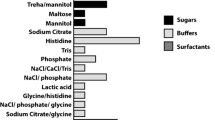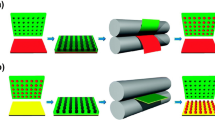Abstract
Purpose. To investigate the feasibility of using the Aerosol Solvent Extraction System (ASES) to produce fine powders of recombinant human deoxyribonuclease (rhDNase), lysozyme-lactose and rhDNase- lactose powders from aqueous based solutions.
Methods. The ASES technique using high pressure carbon dioxide modified with ethanol or ethanol and triethylamine was used for the generation of rhDNase powders and protein-lactose powders from aqueous based solutions. Particle size, morphology, size distributions, crystallinity, and powder aerosol performance were measured. The biochemical integrity of the processed rhDNase was assessed by testing the monomer content and the degree of deamidation.
Results. RhDNase precipitated as spherical particles in the size range between 50 and 500 nm. The primary nano-sized particles were agglomerated to micron-sized clumps of particles during the precipitation process. The median particle size and the fine particle fraction were functions of the operating temperature and the nozzle system used. RhDNase was substantially denatured in the ASES process using carbon dioxide modified with ethanol as anti-solvent. However almost complete recovery of the monomer was achieved using carbon dioxide modified with ethanol-triethylamine as an anti-solvent. Lysozyme-lactose and rhDNase-lactose powders were also precipitated as agglomerated spheres using the ASES process. The powders were amorphous except for those with lactose content higher than 45%.
Conclusions. Micron-sized particles of rhDNase suitable for inhalation delivery were generated from aqueous based solutions using the modified ASES technique. The biochemical integrity of the rhDNase powder is a function of the antisolvent and the operating temperature.
Similar content being viewed by others
REFERENCES
I. Gonda. Inhalation therapy with recombinant human deoxyribonuclease I. Adv. Drug Del. Rev. 19:37-46 (1996).
D. C. Cipolla, I. Gonda, K. C. Meserve, S. Weck, and S. J. Shire. Formulation and aerosol delivery of recombinant deoxyribonucleic acid derived human deoxyribonuclease I, In: J. L. Cleland, R. Langer (eds), Formulation and Delivery of Proteins and Peptides, American Chemical Society, San Francisco, pp. 322-342 (1994).
D. G. Cipolla, I. Gonda, and S. J. Shire. Characterization of aerosols of human recombinant deoxyribonuclease I (rhDNase) generated by jet nebulizers. Pharm. Res. 11:491-498 (1994).
S. D. Yeo, G. Lim, P. G. Debenedetti, and H. Bernstein. Formation of microparticulate protein powders using a supercritical fluid antisolvent. Biotechnol. Bioeng. 41:341-346 (1993).
S. D. Yeo, P. G. Debenedetti, S. Y. Patro, and T. M. Przybycien. Secondary structure characterization of microparticulate insulin powders. J. Pharm. Sci. 83:1651-1656 (1994).
P. G. Debenedetti, J. W. Tom, S. D. Yeo, and G. B. Lim. Application of supercritical fluids for the production of sustained delivery devices. J. Cont. Rel. 24:27-44 (1993).
P. G. Debenedetti, G. B. Lim, and R. K. Prud'homme. Formation of protein microparticles by antisolvent precipitation. European Patent Office 542314A1, 1993.
M. A. Winters, B. L. Knutson, P. G. Debenedetti, H. G. Sparks, T. M. Przybycien, C. L. Stevenson, and S. J. Prestelski. Precipitation of proteins in supercritical carbon dioxide. J. Pharm. Sci. 85:586-594 (1996).
M. A. Winters, P. G. Debenedetti, C. Carey, H. G. Sparks, S. U. Sane, and T. M. Przybycien. Long-term and high-temperature storage of supercritically-processed microparticulate protein powders. Pharm. Res. 14:1370-1378 (1997).
M. Hanna and P. York. Method and apparatus for the formation of particles. World Intellectual Property Organisation WO9501221A1 (1995).
R. T. Bustami, H. K. Chan, F. Dehghani, and N. R. Foster. Generation of micro-particles of proteins for aerosol delivery using high pressure modified carbon dioxide. Pharm. Res. 17:1360-1366 (2000).
D. P. Nesta, J. S. Elliott, and J. P. Warr. Supercritical fluid precipitation of recombinant human immunoglobulin from aqueous solution. Biotechnol. Bioeng. 67:457-464 (2000).
R. Sloan, H. E. Hollowood, G. O. Hupreys, W. Ashraf, and P. York. Supercritical fluid processing: preparation of stable protein particles. Proceedings of 5th Meeting of Supercritical Fluids, Nice, France 1998.
R. Sloan, M. Tservistas, M. E. Hollowood, L. Sarup, G. O. Humphreys, and P. York. Controlled particle formation of biological material using supercritical fluids. Proceedings of the 6th Meeting on Supercritical Fluids, Nottingham, United Kingdom 1998.
M. Pikal. Freeze-drying of proteins. In: J. L. Cleland and R. Langer (eds), Formulation and Delivery of Proteins and Peptides, American Chemical Society, San Francisco, pp. 120-133 1994.
A. D. Clark, N. Dasovich, I. Gonda, and H. K. Chan. The balance between biochemical and physical stability for inhalation protein powders: rhDNase as an example. In: RN Dalby, PR Byron, and SJ Farr (eds), Respiratory Drug Delivery V, Interpharm Press, Buffalo Grove, pp.167-174 1996.
F. Dehghani, T. Wells, N. J. Cotton, and N. R. Foster. Extraction and separation of Lanthanides using dense carbon dioxide modified with tributyl phosphate and di (2-ethylhexyl) phosphoric acid. J. Supercrit. Fluids 9:263-272 (1996).
H.-K. Chan, A. Clark, I. Gonda, M. Mumenthaler, and C. Hsu. Spray dried powders and powder blends of recombinant human deoxyribonuclease (rhDNase) for aerosol delivery. Pharm. Res. 14:431-437 (1997).
N. Y. K. Chew and H. K. Chan. Influence of particle size, air flow, and inhaler device on the dispersion of mannitol powders as aerosols. Pharm. Res. 16:1098-1103 (1999).
H.-K. Chan, K. L. Au-Yeung, and I. Gonda. Effects of additives on heat denaturation of rhDNase in solutions. Pharm. Res. 13:756-761 (1996).
K. L. Toews, R. M. Shroll, C. M. Wai, and N. G. Smart. pH defining equilibrium between water and supercritical carbon dioxide. Influence of SFE of organics and metal chelates. Anal. Chem. 67:4040-4043 (1995).
S. D. Anderson, J. D. Brannan, and H.-K. Chan. Use of aerosols for bronchial provocation testing in the laboratory: where we have been and where we are going. J. Aerosol Med. 15:313-324 (2002).
S. Palakodaty, P. York, and J. Pritchard. Supercritical fluid processing of materials from aqueous solutions: the application of SEDS to lactose as a model substance. Pharm. Res. 15:1825-1843 (1998).
H. K. Chan and I. Gonda. Solid state characterization of spray-dried powders of recombinant human deoxyribinuclease (rhDNase). J. Pharm. Sci. 87:647-654 (1998).
Author information
Authors and Affiliations
Corresponding author
Rights and permissions
About this article
Cite this article
Bustami, R.T., Chan, HK., Sweeney, T. et al. Generation of Fine Powders of Recombinant Human Deoxyribonuclease Using the Aerosol Solvent Extraction System. Pharm Res 20, 2028–2035 (2003). https://doi.org/10.1023/B:PHAM.0000008053.69903.c1
Issue Date:
DOI: https://doi.org/10.1023/B:PHAM.0000008053.69903.c1




